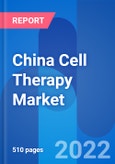Report Highlights:
- More Than 400 Cell Therapies Are In Clinical Trials In China
- 2 Cell Therapies Are Commercially Approved
- Insight on More Than 25 Cell Therapies Proprietary Technologies Developed By Chines Companies
- China Cell Therapy Market Opportunity Assessment
- Insight On More Than 400 Cell Therapies In Clinical Trials By Phase, Indication, Company
- Analysis On Pricing & Reimbursement Framework
- Insight On Key Chinese Pharmaceutical Companies Involved In R&D OF Cell Therapies
China has emerged as one of the world's largest pharmaceutical markets as a result of an exponential rise in clinical research and development activity in recent years. It has additionally evolved into one of the most popular destinations for holding clinical trials, with R&D activity encompassing a variety of therapeutic fields and diseases. Chinese pharmaceutical companies have moved their focus from manufacturing generic drugs to developing innovative drugs and therapies after learning from their international counterparts. The recent advancement in the treatment of cancer, particularly with the introduction of immunotherapy to the international research landscape, was one of the most recent changes in China's pharmaceutical industry.
Immunotherapy has become one of the most sought-after oncology treatments in recent years. China entered this industry slowly, but ever since it did, it has made enormous strides. CAR T Cell therapy is one of the most popular immunotherapies in China. Hundreds of CAR T Cell therapy candidates are currently undergoing clinical trials for the treatment of different diseases worldwide, around 20%-30% of which are being conducted in China, demonstrating the country's growing stature in the pharmaceutical industry. A large number of these clinical trials are being carried out against different forms of cancer, it being the leading cause of death in China and CAR-T cells have emerged as the front runner as the most used cells in the trials. Other immune cells like TIL and TCR have been tested in a fair share of clinical trials but their effectivity has been unsatisfactory which directed the attention of researchers in China towards the development of CAR-T cells, which are genetically engineered human T lymphocytes.
The collection and incubation of CAR-T cells is a time taking process, wherein extra care has to be taken to prevent contamination. To help make this process simpler, many companies have developed proprietary technology platforms to encounter the various obstacles faced in the development process. For instance, FasTCAR, developed by Gracell Bio, reduces the manufacturing time and improved the quality of the T-cells, among other additional benefits. There are many other platforms which have been constructed in recent times for the same purpose and have been the highlight of several partnerships in China’s cell therapy market.
FKC876 and Carteyva, the two CAR-T therapies that have been approved in China, are the products of two joint ventures that came into being, allowing the access of proprietary platforms of Kite Pharma and Juno Therapeutics to their Chinese partners, who then developed the drugs in mainland China. Neither of these two drugs is currently available in the market, nor have the companies revealed any plans of doing so, at least in the near future. Not only large pharma companies but even some CROs and CDMOs in China, like BioHeng, own innovative platforms that substantially reduce the manual effort and time which is invested in the maturation of these cells to be used in the treatment of severe diseases.
The major focus of researchers globally has been on the development autologous cell therapies; however, they have now slowly directed their attention toward the development of allogeneic cell therapies. These provide the same effects as autologous therapies but can be stored by hospitals, allowing a ready-for-use and quick treatment option. This trend has also seeped into the Chinese R&D sector, with clinical trials underway for different hematological malignancies.
The regulatory and policy framework has played the biggest role in this changing market dynamics in china. Historically known for its slow integration towards western companies, its policies have since then evolved and have become more welcoming, urging the entry of more international companies in its pharma industry. This has not only given a boost to its pharma market but has also supported the growth of its domestic pharma companies by allowing the exchange of knowledge and proprietary technologies among companies in return for commercializing drugs developed by these western companies, in China and surrounding regions.
China’s pharma market has been growing rapidly over the last couple of years because of the interplay of several factors. As science and technology evolve and enter China, its cell therapy market, which is already constantly expanding to other indications, is expected to get a boost and will give the US strong competition in the future.
Table of Contents
Samples

LOADING...
Companies Mentioned (Partial List)
A selection of companies mentioned in this report includes, but is not limited to:
- Biocytogen
- BRL Medicine
- CARsgen Therapeutics
- Cellular Biomedicine Group
- Gracell Biotechnologies
- Hebei Senlang Biotechnology
- JW Therapeutics
- Nanjing IASO Biotherapeutics
- Nanjing KAEDI Biotech
- PersonGen Biotherapeutics
- TCRCure
- Ubrigene








